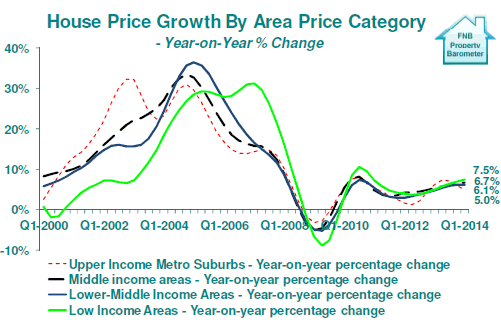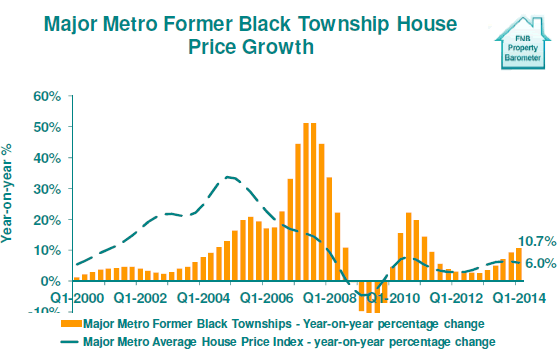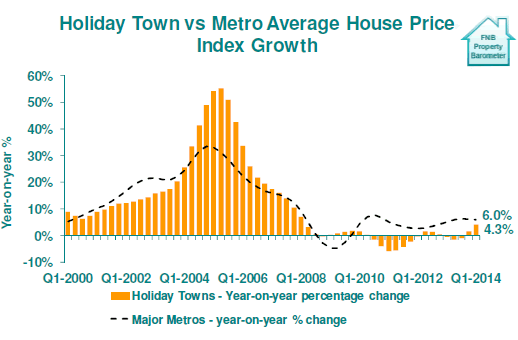Former black townships doing well in housing pricing
 According to FNB household and property sector strategist, John Loos, former Black Townships outperform, holiday towns recovering but still lagging the metros, and Middle Income areas still appear to be a “sweet spot” by a small margin in the “Former Subu
According to FNB household and property sector strategist, John Loos, former Black Townships outperform, holiday towns recovering but still lagging the metros, and Middle Income areas still appear to be a “sweet spot” by a small margin in the “Former Subu
The FNB Area Value Band for the 1st Quarter 2014 that gauges housing pricing in different segments of settlements has identified the former black township as the most preferred when it comes to choosing the most preferred area for low income earners to buy houses.
These areas, commonly referred to as "Low Income Area" in the 1st Quarter 2014 FNB Area Value house price has shown that areas in the former black townships attract buyers of houses whose prices range between R295,800 and R433,369.
The areas have been grouped in four categories of their earning power such as Upper Income Area with a 4th quarter average price of R2.1 million, the "Middle Income Area" with a 4th quarter average price of R1,27 million, the "Lower-Middle Income Area" value band, with an average value of R811,348.
The low Income Area Value Band has been widely praised for its highest price growth of 7.5%, surpassing the Middle Income Areas house price inflation rate of 6.7%, the Lower Middle Income Areas with 6.1 as well as the Upper Income Areas with 5%.

The FNB Area Band of the first quarter goes on to point out that the former black township areas are still the most preferable and affordable places to live by many black households as they see them as areas where their "roots" are located.
Also, another positive factor for demands for township property may be due to the fact that many people are looking for affordability while at the same time available houses are seen to be constrained than in the former affluent white areas.
In the 1st quarter of 2014 and average price growth in the former black township areas in the country's major metropolitan regions of Ekurhuleni, Tshwane, Johannesburg, Ethekwini, Cape Town and Nelson Mandela Bay was estimated to be at 10.7% year-on-year, a jump from the revised 9.4% the previous year.

At the same time, the Lower Middle Income segment, whose price range not far off the R1-million mark, has been seen as something of a "sweet spot" because of the desire by home owners to want to sell so they can upgrade their average price of their homes.
Again, the 1st Quarter 2014 FNB Area Value Band has pointed out that there is not much differences in the performances of the 4 area value bands. Of the four powerful major metros a Holiday Towns Index has been compiled by using data sourced from some of the towns seen as "strongly holiday demand driven". Housing prices are estimated to have grown to 4.3% in the 1st Quarter of 2014 and, this 4.3% Holiday Town price growth rate is the highest growth rate since the 2008 1st Quarter.

CONCLUSION
FNB household and property sector strategist, John Loos says the relative performances of key price segments of the major metro residential markets continue to move in a relatively narrow range.
"When one specially splits out the Former Black Townships, which are on average the most affordable areas of the residential market, we estimate that they have had the fastest price growth, with affordability still a key priority for many households," he said.
He notes that from the FNB Estate Agent Surveys as well as from the average house price growth estimates, the Middle Income areas, with average home values not far above R1m, also appear to be a relative “sweet spot”, albeit by a small margin.
"Finally, we have compared Holiday Town average price growth performance with that of the Major Metros, and while these towns have shown some recovery, they still lag the primary residence-driven metros in terms of price growth. This is to be expected, given the non-essential nature of holiday property buying, and given the still financially constrained household sector." concludes Loos.













